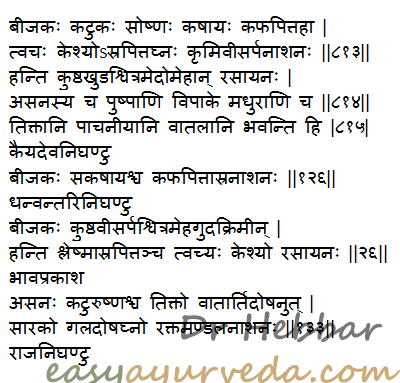Vijaysar- Asana: Pterocarpus marsupium Uses, Research Side Effects
Asana, Beejaka, Vijaysar, Indian Kino tree are different names for Pterocarpus marsupium. It is extensively used for the treatment of diabetes, obesity, diarrhea, vitiligo, eczema, psoriasis etc, in Ayurveda.
Botanical name- Pterocarpus marsupeum
Family-Fabaceae (Simbi kula / Aparajita upakula)
Table of Contents
Vernacular names
Names in different languages:
Hindi name- Vijayasara, Vijaysar, Beejasaar, Beejsar, Bij Sar
English name- Indian Kino tree, Malabar Kino tree
Tamil name – Vegai, Venga katal
Telugu name- Vegisa, Peddagi
Malayalam name- Venga
Kannada name- Banga, Bange mara
Bengali name – Peetashal, Piyasal
Marathi name – Vivala, Bibala
Gujarati name – Biyo
Oriya name – Piashala
Urdu name – Bijasar
Properties, part used, dosage
Vijaysar Medicinal Properties:
Guna (qualities) – Laghu – light to digest, Ruksha – dry
Rasa (taste) – Kashaya – astringent, Tikta – bitter
Vipaka- Katu – Undergoes pungent taste conversion after digestion
Veerya – Sheeta – Coolant
Effect on Tridosha – Balances Kapha and Pitta Dosha.
Part used- Heart-wood, exudate resin
Heartwood is the main usable part of the bark and seeds are also used with little lesser benefits.
Dosage-Decoction 50-100ml; powder 3-6 g
Pharmacological action
Astringent, Anthelmintic, Blood purifier
Home remedies
By Prof. MS Krishnamurthy MD (Ayu), PhD.
Following are few of its simple and effective health remedies-
Inflammatory conditions
1. Leaf paste for inflammatory conditions:
Fresh leaves are collected and fine paste is made. This is warmed a little and applied over the swelling. 3-4 days of medication pacifies the swelling. In petechial hemorrhage also this is beneficial
Type II Diabetes Mellitus
2. Heart wood decoction for Type II DM:
Heart wood coarse powder is made and kept ready. As per the requirement this is made into decoction and administered. In mild to moderate Type II Diabetes mellitus this is found to be very effective.
General method of preparation of decoction (kashaya) – 1 tablespoon of powder is added with 2 cups of water, boiled and reduced to 1 cup, filtered.
In my clinical practice I have suggested this simple remedy to hundreds of people with significant benefits.
Obesity
3. Hot infusion with honey for obesity:
The bark or heart wood coarse powder is added to hot water and kept for a while. Later it is taken as per requirement or whenever the person feels thirsty this is taken. By adding little honey if it is taken there will not be any fear of getting into fatigue, especially in hefty individuals.
Neuritis, numbness
4. Bark decoction for peripheral neuritis and numbness of the limbs:
The bark decoction is very effective in the conditions of neuritis and numbness of the limbs.
The wood of this is used to prepare the cups and by keeping the water in such cups overnight if it is taken it is believed to be good in controlling the sugar.
Most of the time ayurvedic herbs or herbal drugs are inspected or investigated by taking its dominant character or action. Also only its main action is studied or clinically used. In fact, this is not the way of Ayurvedic practice. For example this drug is a good rejuvinative and hair tonic also. But none has proceeded to evaluate its hair tonic effect.Also the drug action will be multi-fold when added with few of its synergistic drugs like Kathaka (Strychnos potatorum) Khadira (Acacia catechu) or turmeric. Instead of imitation(aping),if we adopt the drug with rationality much benefit can be obtained from herbal resources. Or else in few decades herbal drugs too take the shape of modern chemical constituents and true benefit of the classical
Click to consult Dr MS Krishnamurthy MD (Ayu), PhD (Ayu)
Sanskrit verse

Uses, indications
Pterocarpus marsupium uses:
Keshya – Improves hair strength, promotes hair growth
Medohara – reduces fat and cholesterol levels
Rasayana – anti aging, causes cell and tissue rejuvenation
Indicated in –
Raktapitta –Bleeding disorders such as nasal bleeding, heavy periods, etc
Krumi – worm infestation
Visarpa – herpes
Kushta – skin diseases
Shvitra – leucoderma, vitiligo
Meha – diabetes, urinary tract disorders
Gala Dosha – throat disorders
Raktamandala – ringworm infection
Beejaka Flowers
Madhura – sweet
Tikta – bitter
Pachaniya –digestive
Vatala – increases Vata Dosha
External application:
In cases of inflammation, swelling, herpes, leucoderma, tinea infection etc, the leaves paste is prepared with water and applied over the affected area.
In case of external injury, its heart wood paste is applied to relieve pain and swelling.
The bark and twigs are used as a toothbrush. Due to its antimicrobial and anti-inflammatory properties, it makes a good ingredient in herbal tooth powder.
Effect on digestive system:
Resin and bark are used for the treatment of diarrhea, IBS with diarrhea, ulcerative colitis.
In case of intestinal parasites, the bark is made into herbal tea and administered.
Effect on blood: Due to its astringent properties, it balances Pitta, useful in bleeding disorders and gout.
Musculo-skeletal system: It is used both externally and internally to treat rheumatoid arthritis, gout and osteoarthritis. External application relieves pain and inflammation.
Skin disorders:
sushruta Samhita, Chikitsa Sthana, 6th chapter
For all skin diseases, Kadhira – acacia catechu and Beejaka (Vijaysar) can be used.
Beejaka is used as a general skin tonic for a long period of 3 – 4 months to treat chronic skin diseases such as vitiligo, eczema, psoriasis etc. Hence, Beejaka is used as an ingredient in many Ayurveda medicines for skin diseases such as – Maha Manjistadi kashayam, Ayaskriti etc.
Interaction with medicines, supplements
Can this be used while taking Homeopathic medicine?
Yes. This product does not react with homeopathic medicine.
Can this medicine be continued while taking supplements like multivitamin tablets, Omega 3 fatty acids etc?
Yes. Generally, this product goes well with most dietary supplements. However, if you are taking more than one product per day, please consult your doctor for an opinion.
With western
medicines
Seek your
doctor’s advice if you are taking this product along with other western
(allopathic / modern) medicines. Some Ayurvedic herbs can interact with modern
medicine.
If both Ayurvedic and allopathic medicines are advised together, then it is
best to take Allopathic medicine first, wait for 30 minutes and then take the
Ayurvedic medicine.
Ayurveda medicines
Ayurveda medicines with Beejaka as ingredient:
Click on the medicine name to know more about it.
Asana manjishtadi taila – It is an Ayurveda medicine, used mainly in the treatment of headache and eye disorders.
Asana eladi taila – a traditional herbal oil, used in the Ayurveda treatment of headache, ear and eye diseases
Asana Vilwadi taila – in Ayurveda oil used in the treatment of diseases related to eyes, ear and headache.
Narasimha Rasayan – used for the treatment of weakness, weight gain, hair growth and rejuvenation.
Research
Anti-diabetic activity was evaluated on an experimental model by Delhi Institute of Pharmaceutical Sciences and Research (DIPSAR). Type 2 diabetes was induced by administering streptozotocin (90 mg/kg, i.p.) in a neonatal rat model. Aqueous extract of P. marsupium at doses 100 and 200 mg/kg, decreased the fasting and postprandial blood glucose in type 2 diabetic rats.
The 200 mg/kg had had more pronounced effect on postprandial hyperglycemia. The herb improved the body weight of diabetic animals. Cytokine TNF-? was found to be elevated in untreated diabetic rats due to chronic systemic inflammation. The aqueous extract at both doses significantly (P < 0.001) decreased the elevated TNF-? level in type 2 diabetic rats. The researchers concluded that modulation of cytokine TNF-? by the rasayana drug P. marsupium is related with its potential anti-diabetic activity. A clinical study conducted by ICMR on newly diagnosed Type 2 Diabetes Mellitus also found to reduce blood sugar levels.
In vitro study of methanol extract of Anti-bacterial activity was conducted by Molecular Developmental Biology Laboratory, Department of Zoology, M.D.S. University, Ajmer India. Antimicrobial activity was tested against Gram-positive bacteria i.e. Bacillus coagulans and Escherichia coli, gram negative bacteria. Evaluations were based on the inhibition zone using disc diffusion assay. Results showed that Pterocarpus marsupium showed highly significant results against both the bacteria.
Side effects
Because of astringent properties, it is useful in relieving diarrhea. Hence, it is not indicated during constipation.
People with anti diabetic treatment should take this herb with precaution, as it reduces blood sugar levels.
Vijaysar tumbler
Is Vijaysar tumbler really effective?
In the market, tumblers made of Vijaysar are available. It is known by the names – Diabetic tumbler, Vijaysar tumbler etc. It is advised to store water in it at night and to drink the water in the morning, on empty stomach.
Does it work?
Yes, but to some extent only. When you take water stored in it, some amount of phyto-chemicals of Vijaysar will surely get into the water. So, you will have its health benefits. But diabetes cannot be solely controlled with this tumbler water method. At the best, this can be an adjuvant for your efforts to control blood sugar levels.
Habitat, characteristics
Habitat: Hilly regions of Gujarat, Madhya Pradesh, UP, Bihar.
The trees are found in large quantity in South Indian states like Karnataka, Kerala and Tamil Nadu and Odisha. The tree has been cultivated in recent years.
Macroscopical characters of Bark:
- It is a large deciduous tree.
- Bark is thick, gray with vertical cracks.
- Wood is very hard, yellowish brown with darker streaks.
- When wood is soaked in water, water turns blue in color.
Microscopical characters:
Vessels are medium in size.
It is diffuse porous wood.
Ray parenchyma cells are uni to triseriate which are very small in size.
Procumbent and upright cells have been observed in R.L.S.
Morphology
Leaves – Compound, imparipinnate, oblong to obtuse glabrous on both surface
Flower – Pale yellow
Fruit – Pod, nearly circular, glabrous
Chemical composition
Pterocaprus marsupium chemical composition:
Pterocarpol, Marsupol, Maesupin, Carpusin(Marsupsin), (-) epicatechin, Propterol, Pterosupin, Marsupinol, Lupeol.
Resin contains Kino tannic acid, Pyro catechin, epicatechin.
Kino tannic acid is found in heartwood.
Water Soluble Extractive: Not less than 5.00%
Sanskrit synonyms
Asana, Beejaka,
Pitasara – Heart wood of Bijaka is yellow in colour
Pitasalaka – Heartwood resembles Sala ( Shorea robusta) heartwood.
Sugandi – Flowers are aromatic
Karsya – Bijaka is emaciating
Kavya, Priya, Bandhukapushpaka, Shouri, Karshya, Sarjaka, Mahasarja, Tishya, Krushnasarjaka, Pushpavruksha, Alakapriya Peetasara, Peetashalaka,
Sugandha Neela niryasa – exudate / heartwood has pleasant odor
Classical Categorisation
Susruta- Salaasaradi gna
Vabhata- Asanadi Gana
Kaiyadeva Nighantu – Oshadhi Varga
Dhanvantari Nighantu – Amradi Varga
Bhavaprakasha – Vatadi Varga
Rajanighantu – Prabhadradi Varga
Sthanika Karma (Systemic Action)
External Application – It has Anti inflammatory, fracture healing properties. Promote hair growth. Leaf paste can be applied in skin disorders like urticaria, Leukoderma etc. Oil prepared out of is beneficial in premature graying of hair. Gum can be chewed in the tooth ache.
Internal administration-
Digestive system – Absorbent and Anti helminthic. Bark decoction and gum is indicated in diarrhea. Bark decoction and powder is beneficial in Helminthiasis.
Circulatory System – Indicated in Bleeding disorders, Amavata, vatarakta, Sandhi vata etc. associated inflammatory conditions.
Reproductive system – Yoni doshahara (diseases affecting female genitalia)
Excretory system – Decoction of heart wood is indicated in diabetes. Reduces urine output
Satmikarana – For fast healing of fractures and wounds its heart wood decoction along with milk and sugar can be given. . It has a scraping action on tissues hence beneficial in obesity and associated conditions. It has rejuvinative effect on body.
Tvak – Indicated in urticaria, Erysiphales etc.











8 comments
Gowardhan Doddi
Sir, I understood Ayurveda says vijaysar is useful in treating diabetes, But I am not sure many of the commercial businessmen are trying to sell vijaysar tumblers. Do they work and how can we find out if the wood is real or not ??
Dr J V Hebbar MD(Ayu)Author
It works to some extent, but I do not have any idea about its genuineness.
Sanjeev Gupta
ITS IS VERY USEFULLY FOR type 2 diabetic
poorna chandhrika
can this tree powder can be taken by pregnant women or will it cause any side effect on child
Dr J V Hebbar MD(Ayu)Author
If the pregnant mother is diabetic, then it is advised.
sanjay kumar
kiya ye diabetes m pura kam karta h
Raj
Dear sir
Where will we find this tree in punjab
Ramesh
It really works for diabetic and arthritis partical facts and experience